On the Horizons, Part 1
Today is my first of two columns telling card-by-card design stories from Modern Horizons 2. Modern Horizons sets have a greater density of nostalgia baked into them than most sets, so there's lots to talk about. Let's get to it.
Aeve, Progenitor Ooze
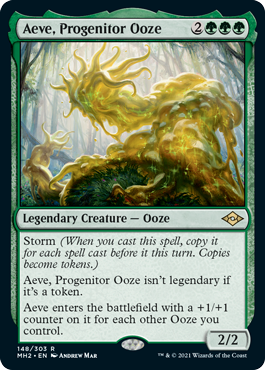
Last year, we changed the rules for how copying worked. If you copied a permanent, it resulted in you making a token copy of that permanent. This change has allowed us to make some cards we could never make before, and this card is one such example.
Back in Scourge, Brian Tinsman wanted to create a mechanic that encouraged you to play a lot of spells on the same turn. The reward for doing so was that your spell got copied once for each spell that you had previously cast that turn. This mechanic was called storm, and if you know your Magic history, it proved very powerful (so much so that my scale of how hard it is to return to Standard is named after it).
Aaron and his Set Design team decided to build an archetype around the storm mechanic (red-green), which allowed them to do something Magic hasn't done before—make a creature with storm. (I will say Storm Entity from Future Sight was a noble attempt to do so in spirit.)
It seemed only right to a.) put it on a legendary creature and b.) make that creature an Ooze, a creature known for splitting into many copies of itself. As long as we were doing those two things, it seemed only right to make the card something that boosted Oozes so you could build around it. The key to making it all work was realizing that the copies themselves couldn't be legendary.
Altar of the Goyf
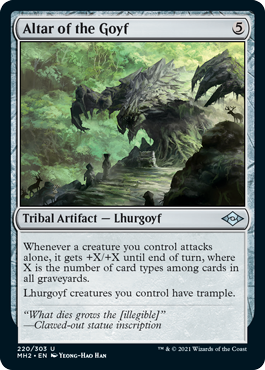
I'm going to jump right to the point and answer the question I assume a lot of you had when you saw this card: is the Tribal creature type back? Technically, yes, and realistically, no. I mean yes, this card has it, so yes, it has returned, but it's a special case and not something to signify that we'll be using it on a regular basis. Modern Horizons 2 is a high-complexity, nostalgia-rich set. If there's ever a place to dip our toe into things we've stopped doing, this is the place.
The reason Altar of the Goyf has the Tribal creature type is because there's a delirium archetype and having an uncommon Tribal card helps with it. The card is also very Lhurgoyf in flavor, so giving it "Tribal — Lhurgoyf" flavorfully made sense. There's also a fun trick if you animate it where it gives itself trample.
I do want to stress that, while this means we might be willing to use Tribal on a very limited basis when something in the right set with the right audience allows it, this is not a sign of the Tribal card type returning in any major way.
Asmoranomardicadaistinaculdacar and The Underworld Cookbook
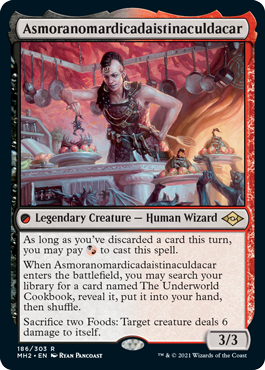
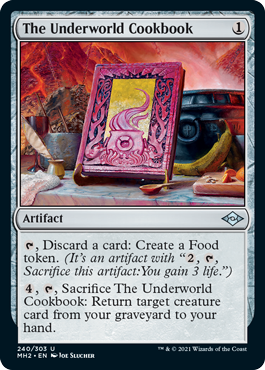
Alpha had the following card:
Mechanically, the card didn't attract much attention. It's the kind of creature that's mostly good in Limited at a time where Limited wasn't really a thing yet. However, the flavor text captured a lot of attention.
The idea of a cookbook where a chef describes how to prepare exotic fantasy creatures was a cute concept, but I think what got noticed most was the length of the cook's name. It was long, comically long. Ironically, the very thing that made players fall in love with the character was the thing that kept us from making her for so many years. You see, you can't fit her name and a mana cost on the title bar.
The idea of making Asmoranomardicadaistinaculdacar a card came up often. I know she was in the Time Spiral file for a while. She's a beloved flavor-text character, and Magic loves making nostalgic throwback legendary creatures. The problem we kept running into was her name. We investigated several workarounds. What if we called her the Underworld Cook or Asmorano* (with the rest of the text in the text box)? None of those seemed like the right execution.
I believe the idea of making her also came up during the first Modern Horizons, but we still couldn't crack how to design the card. Well, Modern Horizons 2 found the solution—don't include a mana cost. Magic has done other cards that you couldn't cast (there's even a whole cycle in this set), so why not use that technology here? How exactly we executed on this idea went through many iterations. Here's the earliest version of the card:
Asmoranomardicadaistinaculdacar
(no mana cost)
Legendary Creature — Human Wizard
1, Sacrifice a creature: Create a Food token. You may activate this ability from the battlefield or your graveyard.
Put CARDNAME into your graveyard from your hand or the command zone: Create a 1/1 blue Beeble creature token.
0/2
This version didn't give you a direct way to get her onto the battlefield (leaving it up to other cards), but it did give you a way to get her into the graveyard and allowed her first ability to work in the graveyard. Obviously, as she's a cook, the card makes Food tokens. Her second ability makes a 1/1 blue Beeble. I assume a Beeble token was chosen because the Unhinged card Sauté is one of three cards that quotes her in the rules text, and the card shows her cooking Beebles.
Here's the next version of her rules text:
BR, Discard CARDNAME: It deals 2 damage to any target and you lose 2 life. Draw a card.
1, Sacrifice a creature: Create a Food token. You may activate this ability while CARDNAME is on the battlefield or in your graveyard. (A Food token is an artifact with "{o2}, {oT}, Sacrifice this artifact: You gain 3 life.")
This ability gives you a way to discard the card for an effect, but now it comes with a mana activation cost and drains a target for 2 rather than making a 1/1 Beeble. It kept the sacrifice ability but made it secondary on the card so that you see the way to get the card into your graveyard before being told you can use it in the graveyard.
Next up:
Madness BR (If you discard this card, you may cast it for its madness cost instead of putting it into your graveyard.)
Sacrifice another creature: Create a Food token.
(b/r), Discard a card: Return this card from your graveyard to your hand.
This version added madness to the card, giving you a way to directly get it onto the battlefield. Sacrificing a creature for Food stayed, but we took away the mana activation cost.
The final ability is something new, a way to get the card out of the graveyard back into your hand. My best guess is that this ability was designed for the black-red madness deck and allowed it to be a madness enabler when it was in your graveyard. Also, this is the version where the creature changed from a 0/2 to a 3/3.
Here's the next change:
Madness {o(b/r)} (If you discard this card, discard it into exile. When you do, cast it for its madness cost or put it into your graveyard.)
{oB}, Discard a card: Create a Food token.
{oR}, Discard a card: Return this card from your graveyard or the command zone to your hand.
This version changed the madness cost from requiring both black and red to only requiring black or red using hybrid mana. The design team then tweaked the second two abilities, tying each one to one of the two colors.
Sacrificing a creature to make Food turned into a discard cost instead and got a black mana activation. This allowed the Underworld Cook to enable madness while on the battlefield. The added red activation cost to the second ability expanded the ability to work with the command zone. We don't often reference the command zone outside of Commander products, but this card was clearly designed to be a Commander, so I assume they were planning to make an exception.
Here's the penultimate version:
If you've discarded a card this turn, you may cast this spell by paying (b/r).
Partner with The Underworld Cookbook (When this creature enters the battlefield, target player may put the Cookbook into their hand from their library, then shuffle.)
Sacrifice two Foods: Destroy target creature.
This version made a couple changes. First up, it changed madness to a more general ability that let you cast it if any card had been discarded, not just this one.
Second, the design team decided they wanted Underworld Cookbook to be its own card, so they connected them together mechanically. They then moved discarding to make Food to The Underworld Cookbook. This freed the card from having to make Food, as the Underworld Cookbook would do that. The Underworld Cookbook was also given a way to get back a creature card in the graveyard.
Third, the card moved away from having colored activation costs. Instead, a third ability was added that let you turn Food into creature destruction. The finished card is close to this version. It doesn't actually use the partner mechanic but allows you to do something similar. The creature destruction effect was tweaked, I believe, for added flavor. She feeds the creature something that kills it.
That, in many steps, was how Asmoranomardicadaistinaculdacar finally made it to print.
Chatterfang, Squirrel General
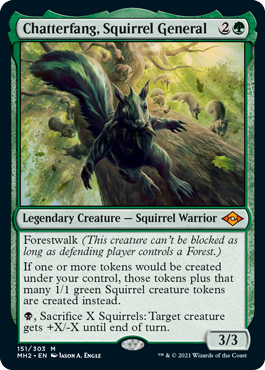
I didn't design Chatterfang, Squirrel General, but I did design this card:
Since I understand the difficulty of designing a Squirrel commander, I thought I'd walk through the main challenges:
Challenge #1: There aren't enough Squirrels to make a whole Commander deck.
Prior to Modern Horizons, there are only ten creatures that are Squirrels (six green, two black, one white, and one artifact). There are also fifteen non-Squirrel cards that create Squirrel tokens (fourteen green and one artifact). That's not enough to fill out a 100-card deck. Modern Horizons 2 does add three new Squirrels (two green and one black-green) and nine new Squirrel token makers (five green, two black, one black-green, and one blue), but even with all that added in, it's still not quite enough, and it definitely doesn't allow you to make many deck-building decisions about which Squirrel cards to include.
Challenge #2: Squirrels are mostly a 1/1 creature token-based tribe.
I believe the humor of Squirrels is that it's fun to see something taken down by an army of cute little creatures. This means that, in most cases, a Squirrel deck is about getting a lot of 1/1 creature tokens on the battlefield. Any commander has to help you win with that as your major resource.
Challenge #3: The deck doesn't have a lot of answers to creatures.
One of the problems when your strategy is mainly focused on making small creatures is that you don't have a lot of answers to big creature threats. One of the things a commander needs to do is make sure a Squirrel deck can deal with creatures, especially ones that don't attack.
There are a number of different ways to address the first concern. Acornelia not only allowed you to include cards that were connected to Squirrels in their text but also in their art. That's an Un- answer, though, as black-bordered cards can't care about what's in the art of a card. Earl of Squirrel turned all your tokens into Squirrels, so it allowed you to play other token-making cards. Chatterfang follows the Earl of Squirrel path. Since whenever you make any token, you also make Squirrel tokens, it allows you to supplement your Squirrel cards with token-making cards.
The token making also helps with the second challenge. The key to winning with 1/1 creature tokens is to make so many that you overwhelm your opponent. Chatterfang's second ability helps do that even with Squirrel-making cards, as it just allows your token makers to make more tokens.
The third challenge is addressed by Chatterfang's last ability. It lets you turn your Squirrels into a resource that can kill creatures (or pump up your attackers as a way to help finish the game, so it also helps with challenge number two. The third ability was given a black activation cost to give the card a black-green color identity and help reinforce that Squirrels is the black-green archetype in Modern Horizons 2.
The last thing to mention is the first ability that I skipped over. As I talked about with the Tribal creature type, Modern Horizons 2 is willing to dip its toe into abilities we don't use anymore. Forestwalk isn't in active use, but how can you not give the leader of the Squirrels forestwalk?
Dakkon, Shadow Slayer
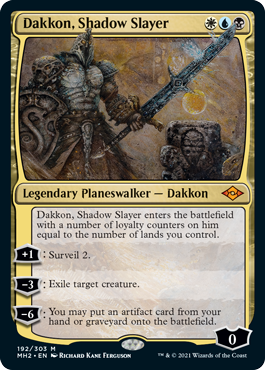
Dakkon Blackblade first showed up as a legendary creature in the Legends expansion (Magic's third-ever expansion). Legends had introduced the concept of legendary permanents, and there were many legendary creatures in the set based on characters from various roleplaying games that Lead Designer Steve Conrad and members of his design team had played. Dakkon Blackblade's card was one of the most popular of the legendary creatures in the set. (At the time, though, creatures were creature type Legend rather than the supertype legendary.)
Dakkon would go on to star in a comic and appear in a book (The Book of Geyadrone Dihada). In those, he became a Planeswalker, but at the time, planeswalkers weren't a card type, so there was no way to give him a card to represent that part of the story.
Flash forward to Modern Horizons 2 design. Ethan Fleischer, the set's vision design lead, was looking for some flavorful planeswalkers from the past (Modern Horizons had a Serra planeswalker) and was excited by the idea of bringing a Dakkon Blackblade planeswalker to life on a card.
Here was the first attempt:
Dakkon the Shadowless
WUB
+1: Look at the top X cards of your library, where X is the number of lands you control. Put one into your hand and the rest on the bottom of your library in a random order.
-3: Target creature gets -X/-X until end of turn, where X is the number of lands you control.
-8: Create X 1/1 white Soldier creature tokens, then search your library for up to X Equipment cards and put them onto the battlefield, each attached to a different one of those tokens. X equals the number of lands you control, then shuffle your library.
Loyalty - 4
Dakkon had to be white-blue-black, as those were the colors of his legendary creature card in Legends, and the character didn't really change colors throughout the story. The earliest version had three different abilities that all scaled based on how many lands you controlled. This was a tie to the Legends card where his power and toughness scaled based on your number of lands. (Scaling on lands isn't really a white-blue-black thing, but we allowed a little bend to match the flavor.)
You'll notice that each ability is primarily one of his three colors. The first is library searching, which is blue. The second is granting -X/-X, which is black. The third is 1/1 creature token making, which is primarily white.
Which brings us to the next version:
CARDNAME enters the battlefield with a loyalty counter for each land you control.
0: Look at the top three cards of your library. Put one of them into your hand and the rest into your graveyard.
−2: You may put an artifact card from your hand or graveyard onto the battlefield.
-5: Exile target creature.
The big switch with this design is that instead of using the amount of lands you control to define Dakkon's abilities, it defines his loyalty. Again, the abilities were chosen to be generally useful effects that represented the three colors. The first ability is library searching, blue. The second ability is reanimation, black. The third ability is exiling creatures, white. (The second and third abilities are both something white and black do.) The effects also had to be chosen so they weren't broken if late-game Dakkon enters with a lot of loyalty. I should also mention the second ability reinforces that Dakkon was an artificer (remember, he forged the Blackblade).
The final version is close to this one with a few tweaks. The first ability officially got named surveil, as this is Modern Horizons 2, a set where we can reference nonevergreen abilities on a single card. The second and third abilities were swapped, and the loyalty costs were changed.
Jade Avenger
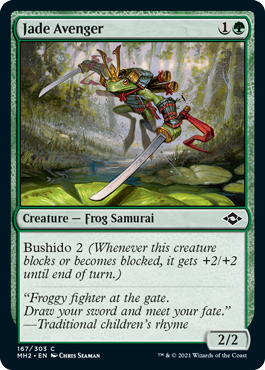
The term "deep cut" started in music as a way to denote songs that no one but the biggest fans of the artist would know. In Magic design, we use the term "deep cut" as a reference to what we think the majority of the audience won't get, but the ones who do will really like it. Jade Avenger is an example of a deep cut. For those who don't already appreciate the card, let me fill you in on what you're missing.
Our story starts back in 1995 with the card Chub Toad, which appeared in the set Ice Age.
There once was a man named Shawn Carnes who worked for many years in R&D. (Shawn isn't dead or anything. He just hasn't worked at Wizards for many years.) Before Shawn moved to R&D, he ran the customer service department. During that time, Shawn was known for using the phrase "bad touch." It meant that someone had said something that they probably shouldn't have said. When Ice Age got made, the design team put in a card that was a nod to Shawn. Chub Toad was an anagram of "Bad Touch," and the art showed someone (it was supposedly Shawn) being eaten by the giant toad (later changed to be a Frog). To show that the creature puffed up and became bigger, the design team had it get +2/+2 when in combat. From time to time, we used the ability to get a stat bonus when in combat. We called the ability Chub Toad after the card that first premiered it.
Eventually, Brian Tinsman decided to make a mechanic out of the Chub Toad ability. Brian was looking for a simple combat ability for the Samurais, and the Chub Toad ability seemed perfect. It was named bushido, which means "the way of the warrior." Champions of Kamigawa was our first top-down block, so we decided to give the keywords very rich, in-world names to help reinforce the flavor.
Normally, when we take an old ability and officially keyword it, we'll go back and change the old cards that have the ability to have the keyword. The problem was that Chub Toad was a giant Frog, and it having bushido just didn't make any sense flavorfully. We talked about just giving it bushido anyways. Maybe it's secretly a Frog Samurai, we joked. In the end, we decided not to do the errata and just left Chub Toad de-bushido-ed.
Jade Avenger is righting that wrong. Chub Toad is back, but this time as a Frog Samurai so that it can properly get the bushido it's long deserved. The flavor text is a nod to the original card that had a similar children's rhyme on it. And that is the "deep cut" that is Jade Avenger.
Our Story Comes to an End
That's all the time I have for today. I hope you've enjoyed the stories and am eager for any feedback you might have, be it on this article, any of the cards I talked about, or on Modern Horizons 2 itself. You can email me or contact me through any of my social media accounts (Twitter, Tumblr, Instagram, and TikTok).
Join me next week for more card-by-card design stories from Modern Horizons 2.
Until then, may you discover more fondly remembered references as you play with the set.
#839: WAR with Doug Beyer
#839: WAR with Doug Beyer
30:51
I sit down with Creative team member Doug Beyer to talk about the creation of War of the Spark.
#840: Planeswalkers, Part 1
#840: Planeswalkers, Part 1
37:26
This podcast is part one of a three-part podcast walking through every Planeswalker that's ever gotten a card.
- Episode 838 Unglued, Part 3
- Episode 837 Ikoria with Dave Humpherys
- Episode 836 Unglued, Part 2

